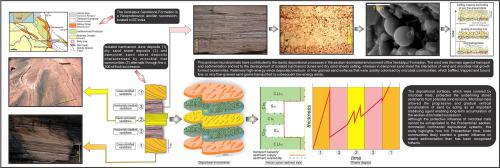当前位置:
X-MOL 学术
›
Precambrian. Res.
›
论文详情
Our official English website, www.x-mol.net, welcomes your
feedback! (Note: you will need to create a separate account there.)
Microbial Influence on the Accumulation of Precambrian Aeolian Deposits (Neoproterozoic, Venkatpur Sandstone Formation, Southern India)
Precambrian Research ( IF 3.2 ) Pub Date : 2020-09-01 , DOI: 10.1016/j.precamres.2020.105854 Giorgio Basilici , Marcus Vinicius Theodoro Soares , Nigel Philip Mountney , Luca Colombera
Precambrian Research ( IF 3.2 ) Pub Date : 2020-09-01 , DOI: 10.1016/j.precamres.2020.105854 Giorgio Basilici , Marcus Vinicius Theodoro Soares , Nigel Philip Mountney , Luca Colombera

|
Abstract In many presently active aeolian systems, processes of sediment erosion, transport and deposition are markedly influenced by vegetation, which acts as an important sediment stabilising agent. Current sedimentary models for hyperarid continental settings devoid of vegetation and with adequate sand supply and wind force envisage intense aeolian activity, resulting in the construction of extensive aeolian sand-seas (ergs). During the Proterozoic, the Earth’s surface was devoid of vegetation, yet ergs are not so common in Proterozoic continental successions. High water-table levels, and erosional reworking by fluvial or marine processes are recognised as possible factors that restricted accumulation and preservation of extensive Proterozoic aeolian systems. By contrast, Proterozoic biotic communities have traditionally been considered largely incapable of markedly influencing clastic sedimentary processes in continental settings. However, since it is now known that bacteria have colonised parts of the continental Earth's surface since the Palaeoarchean, a question arises as to whether such organisms might have exercised some control on aeolian processes via substrate stabilisation. The Neoproterozoic Venkatpur Sandstone Formation (maximum age 709 Ma) is an aeolian depositional unit comprising small, isolated barchanoid and transverse dunes, and dry and damp sand sheet palaeoenvironments. Water-table-influenced aeolian sand-sheet deposits composed of thin sand layers that alternate with a suite of microbially induced sedimentary structures (MISS) provide evidence for fossilised bacteria. These strata record the interaction between microbial mats and aeolian depositional processes, which enabled the construction and accumulation of sand deposits. As microbial mats stabilised and provided plasticity to the depositional accumulation surface, they protected underlying (i.e. accumulated) aeolian deposits from possible wind erosion, reducing the possibility that these stored deposits could be recycled as lagged input to a downwind aeolian system. The stabilising influence of the microbial mats enabled the accumulation of the aeolian deposits, resulted in a marked decrease in the availability of sand for aeolian transport, and hindered construction and accumulation of large aeolian bedforms. This depositional model highlights the significance of the microbial mats for controlling the depositional processes in Precambrian aeolian-dominated environment. Probably, this model may be applied to other pre-vegetated Earth continental environments.
中文翻译:

微生物对前寒武纪风成沉积物堆积的影响(新元古代,Venkatpur 砂岩组,印度南部)
摘要 在目前许多活跃的风成系统中,沉积物的侵蚀、输送和沉积过程受到植被的显着影响,植被是重要的沉积物稳定剂。目前没有植被且有足够的沙子供应和风力的超干旱大陆环境的沉积模型设想了强烈的风沙活动,导致广泛的风沙海(erg)的建设。在元古代,地球表面没有植被,但在元古代大陆演替中,ergs 并不常见。高地下水位以及河流或海洋过程造成的侵蚀改造被认为是限制广泛的元古代风成系统积累和保存的可能因素。相比之下,元古界生物群落传统上被认为在很大程度上无法显着影响大陆环境中的碎屑沉积过程。然而,由于现在已知细菌自古太古代以来就已经在地球大陆表面的部分地区定居,因此出现了一个问题,即这些生物是否可能通过底物稳定作用对风成过程进行了一些控制。新元古代 Venkatpur 砂岩组(最大年龄 709 Ma)是一个风成沉积单元,包括小的、孤立的新月形沙丘和横向沙丘,以及干燥和潮湿的沙板古环境。受地下水位影响的风积砂层沉积物由薄砂层组成,与一组微生物诱导的沉积结构 (MISS) 交替,为细菌化石提供了证据。这些地层记录了微生物垫和风积沉积过程之间的相互作用,这使得砂沉积物的形成和堆积成为可能。由于微生物垫稳定并为沉积堆积表面提供可塑性,它们保护潜在的(即堆积的)风积沉积物免受可能的风蚀,降低了这些储存的沉积物可以作为滞后输入再循环到顺风风积系统的可能性。微生物垫的稳定影响使风积沉积物得以积累,导致用于风积运输的沙子的可用性显着减少,并阻碍了大型风积床的构建和堆积。该沉积模型强调了微生物垫在控制前寒武纪风成主导环境中的沉积过程方面的重要性。或许,这个模型可以应用于其他有植被的地球大陆环境。
更新日期:2020-09-01
中文翻译:

微生物对前寒武纪风成沉积物堆积的影响(新元古代,Venkatpur 砂岩组,印度南部)
摘要 在目前许多活跃的风成系统中,沉积物的侵蚀、输送和沉积过程受到植被的显着影响,植被是重要的沉积物稳定剂。目前没有植被且有足够的沙子供应和风力的超干旱大陆环境的沉积模型设想了强烈的风沙活动,导致广泛的风沙海(erg)的建设。在元古代,地球表面没有植被,但在元古代大陆演替中,ergs 并不常见。高地下水位以及河流或海洋过程造成的侵蚀改造被认为是限制广泛的元古代风成系统积累和保存的可能因素。相比之下,元古界生物群落传统上被认为在很大程度上无法显着影响大陆环境中的碎屑沉积过程。然而,由于现在已知细菌自古太古代以来就已经在地球大陆表面的部分地区定居,因此出现了一个问题,即这些生物是否可能通过底物稳定作用对风成过程进行了一些控制。新元古代 Venkatpur 砂岩组(最大年龄 709 Ma)是一个风成沉积单元,包括小的、孤立的新月形沙丘和横向沙丘,以及干燥和潮湿的沙板古环境。受地下水位影响的风积砂层沉积物由薄砂层组成,与一组微生物诱导的沉积结构 (MISS) 交替,为细菌化石提供了证据。这些地层记录了微生物垫和风积沉积过程之间的相互作用,这使得砂沉积物的形成和堆积成为可能。由于微生物垫稳定并为沉积堆积表面提供可塑性,它们保护潜在的(即堆积的)风积沉积物免受可能的风蚀,降低了这些储存的沉积物可以作为滞后输入再循环到顺风风积系统的可能性。微生物垫的稳定影响使风积沉积物得以积累,导致用于风积运输的沙子的可用性显着减少,并阻碍了大型风积床的构建和堆积。该沉积模型强调了微生物垫在控制前寒武纪风成主导环境中的沉积过程方面的重要性。或许,这个模型可以应用于其他有植被的地球大陆环境。











































 京公网安备 11010802027423号
京公网安备 11010802027423号